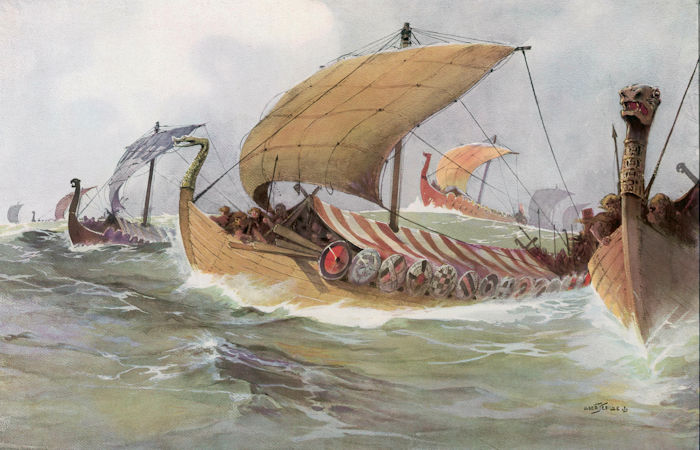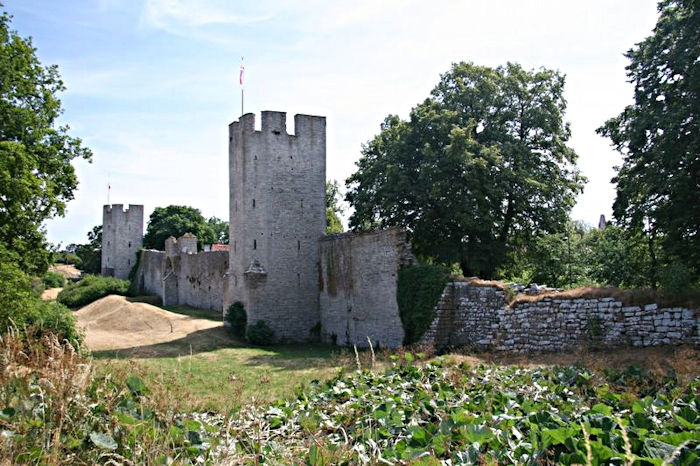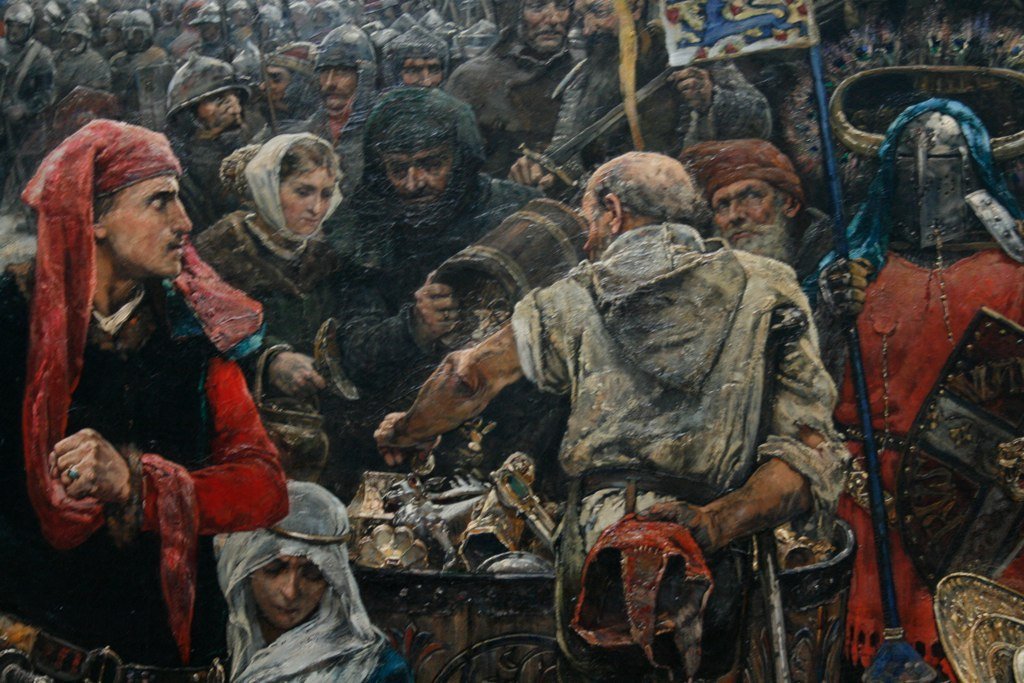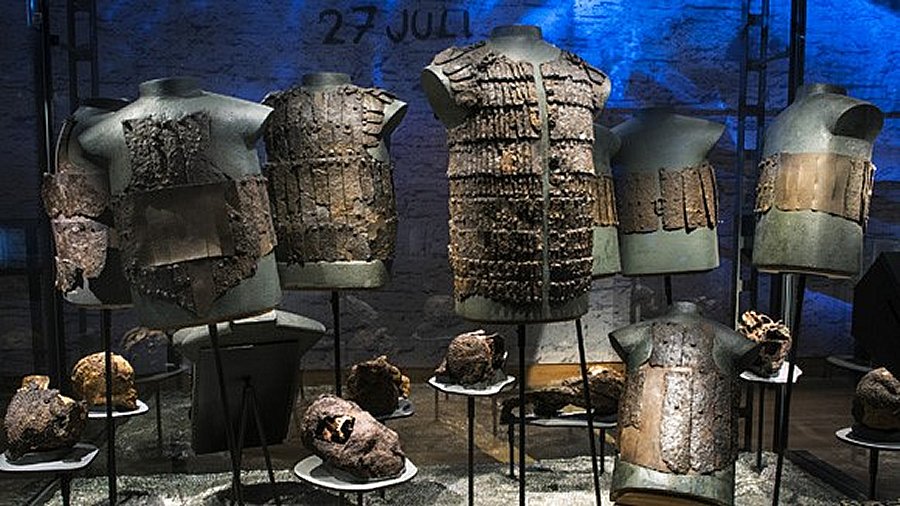Battle Of Visby – Death Came With King Atterdag’s Ships
A. Sutherland - AncientPages.com - Once upon a time, there was an important commercial center on Gotland, the island located in the Baltic Sea, approximately 90 kilometers east of mainland Sweden.
Credit: Adobe Stock - Archivist
Gotland's center of an extensive trading network stretched from Karelia in northern Finland down to the Caspian Sea in the south. The island flourished during Antiquity and Middle Ages, and its wealth in medieval times led to impressive architecture and local art development.
The death came in the summer of 1361. When a Danish army sailed eastward summer of 1361, the Swedish king Magnus Eriksson knew Gotland was in danger.
Picture of the Visby city wall, near the north gate. The main battle was fought within 300 meters of the city's fortifications. Credit: Benranton - Public Domain
He did what he could; he had issued a warning letter to the citizens of Gotland about a dangerous attack approaching the island of Gotland. The population of Gotland was preparing for the worst.
Early on the morning of Thursday, July 22, the enemy fleet was seen. The armada consisted of thirty ships, massive cogs, and smaller shells.
The rumor of the Danish attack spread rapidly across the island; soon, all church bells rang across the island – the danger was imminent.
Soon, the Danish king, Valdemar IV Atterdag, and his soldiers appeared on the horizon outside Visby's thick city walls.
The cruel plundering of the island by King Valdemar definitely ended the island's prosperity. Credit: Carl Gustaf Hellqvist - Public Domain
They landed on the coast of Eksta Parish, Gotland, and the Danish troops moved towards Visby. The clashes began and culminated on July 27, just outside the city walls.
The main battle was fought within 300 meters of the city of Visby's fortifications. Roughly 1,800 Gotlanders had been killed, up to half of the participants - an exceptionally high loss ratio.
Following the devastating battle, the citizens of Visby decided to surrender to avoid further losses.
The exhibition "The massacre at the Great Wall, the Battle of Gotland in 1361" at the Historical Museum in Stockholm. "These findings are unique in the world, it is like a keyhole back to 1361. Photo: gotland.net/Historiska Museet Stockholm
Visby opened its gates to the victorious Danish army. Without outside help from fighting farmers, Visby would never be able to keep out Valdemar's forces.
Negotiations began. The inhabitants paid much of their wealth to King Valdemar to save the city from sacking. Despite the payment, the Danes still plundered several of the town's churches and monasteries on the island before they left. King Valdemar appointed sheriffs to govern Visby and then set sail again. It would take another year before Valdemar officially added "King of Gotland" to his many titles.
The cruel plundering of the island by King Valdemar definitely ended the island's prosperity.
However, one of Atterdag's ships carrying all the island's treasures sunk off the Carl islands west of Gotland.
Not long ago, a wood wreck was found outside the island Gotland, at a depth of 100 meters in a secret location between the two Baltic isles. Based on the sonar pictures, experts estimated that a small vessel was 28 meters long and 7 meters wide.
No cogs have ever been found in the area despite the extent of their use and the perfect conditions of the Baltic Sea for wreck preservation.
The seabed of the Baltic is flat, and the oxygen levels in the water are low enough to make it an ideal environment for wrecks to remain intact. Many shipwrecks were found in the Baltic Sea, according to researchers.
None of them, however, has been recognized as King Atterdag's lost ship with Gotland's treasures. The loot is resting somewhere in the underwater realm of the Baltic Sea near Gotland.
Only a few ancient written sources can tell about the Battle of Visby, Gotland. On the other hand, archaeological excavations have found out what happened on these tragic days of July 1361.
Outside Visby's city walls, archaeologists have unearthed five mass graves related to the tragic medieval battle.
The first grave was excavated in 1905, and each grave contained hundreds of victims; two more mass graves the research team investigated between 1909 and 1928.
One-third of the Gotland army were children, older men, and cripples. While the farmers were dying, the citizens of Visby just watched helplessly from the ramparts.
A few decades later, the memorial cross was erected on the mass graves.
Oral tradition is that the Danish king and his army raided southern Gotland for a month. On the return journey, some Danish ships with treasures are said to have been wrecked in a storm at the Karlsö islands - a group of islands off the west coast of Gotland that consists of Stora Karlsö and Lilla Karlsö.
People say that even today, when the weather is calm, you can see the treasures gleaming at the bottom of the sea. Is it symbolic revenge on the king, responsible for so much damage to the island and pain to the people of Gotland?
Written by – A. Sutherland AncientPages.com Staff Writer
Copyright © AncientPages.com All rights reserved. This material may not be published, broadcast, rewritten or redistributed in whole or part without the express written permission of AncientPages.com
Expand for referencesReferences:
Lingström, Maria (2007). Mästerby 1361- gutarnas strid mot Valdemar Atterdag.
More From Ancient Pages
-
 Previously Uncounted Copies Of Newton’s Groundbreaking ‘Principia’ – Discovered
News | Nov 11, 2020
Previously Uncounted Copies Of Newton’s Groundbreaking ‘Principia’ – Discovered
News | Nov 11, 2020 -
 Ice Core Records From Greenland Tell Stories Of Rise And Fall Of Ancient European Civilizations
Archaeology | May 24, 2018
Ice Core Records From Greenland Tell Stories Of Rise And Fall Of Ancient European Civilizations
Archaeology | May 24, 2018 -
 Extraordinary Fossils From The End Of The Age Of The Dinosaurs – Study
Paleontology | Oct 15, 2023
Extraordinary Fossils From The End Of The Age Of The Dinosaurs – Study
Paleontology | Oct 15, 2023 -
 Legend Of Jin Chan: The ‘Golden Toad’ – Money Frog That Brings Luck And Is A Feng Shui Charm
Chinese Mythology | May 5, 2016
Legend Of Jin Chan: The ‘Golden Toad’ – Money Frog That Brings Luck And Is A Feng Shui Charm
Chinese Mythology | May 5, 2016 -
 Medieval Manor Of Court De Wyck – Re-Discovered
Archaeology | Oct 10, 2023
Medieval Manor Of Court De Wyck – Re-Discovered
Archaeology | Oct 10, 2023 -
 The Wild Hunt – Danger Of Seeing The Phantom Army Of Odin
Featured Stories | Nov 7, 2021
The Wild Hunt – Danger Of Seeing The Phantom Army Of Odin
Featured Stories | Nov 7, 2021 -
 Burial Practices In Unified Cultures Of Early Medieval Europe
Archaeology | Jan 22, 2021
Burial Practices In Unified Cultures Of Early Medieval Europe
Archaeology | Jan 22, 2021 -
 Seven Fires Prophecy Of The Anishinaabe People And The Future Of The Turtle Island – Are Humans Standing At The Crossroads?
Myths & Legends | Feb 14, 2019
Seven Fires Prophecy Of The Anishinaabe People And The Future Of The Turtle Island – Are Humans Standing At The Crossroads?
Myths & Legends | Feb 14, 2019 -
 Seven Gods Of Happiness – Bring Luck, Prosperity And Health In Japanese Folk Belief
Featured Stories | Jun 29, 2020
Seven Gods Of Happiness – Bring Luck, Prosperity And Health In Japanese Folk Belief
Featured Stories | Jun 29, 2020 -
 Mystery Of The Lost Golden Chain Of Huayna Capac: Will The Ancient Inca Treasure Ever Be Found?
Artifacts | Dec 30, 2020
Mystery Of The Lost Golden Chain Of Huayna Capac: Will The Ancient Inca Treasure Ever Be Found?
Artifacts | Dec 30, 2020 -
 New Unique Ancient Underwater Finds In The Ports Of Caesarea And Acre
Archaeology | Aug 11, 2021
New Unique Ancient Underwater Finds In The Ports Of Caesarea And Acre
Archaeology | Aug 11, 2021 -
 Famed Makishi Dancers And Likumbi Lya Mize Ceremony In Zambia – Much More Than Just A Festival
Ancient Traditions And Customs | Aug 6, 2019
Famed Makishi Dancers And Likumbi Lya Mize Ceremony In Zambia – Much More Than Just A Festival
Ancient Traditions And Customs | Aug 6, 2019 -
 Agora: An Ancient Meeting Place Visited By Many Famous Philosophers
Ancient History Facts | Apr 13, 2016
Agora: An Ancient Meeting Place Visited By Many Famous Philosophers
Ancient History Facts | Apr 13, 2016 -
 World’s Oldest Depiction Of A Ghost Discovered On 3,500-Year-Old Babylonian Tablet
Archaeology | Oct 20, 2021
World’s Oldest Depiction Of A Ghost Discovered On 3,500-Year-Old Babylonian Tablet
Archaeology | Oct 20, 2021 -
 One-Eyed Giants Fachan Were As Dangerous As Polyphemus And The Cyclops
Celtic Mythology | May 21, 2019
One-Eyed Giants Fachan Were As Dangerous As Polyphemus And The Cyclops
Celtic Mythology | May 21, 2019 -
 Ancient Roman Street And Buildings Discovered Beneath Exeter Cathedral
Archaeology | Apr 4, 2023
Ancient Roman Street And Buildings Discovered Beneath Exeter Cathedral
Archaeology | Apr 4, 2023 -
 DNA From Doggerland That Separates The UK From Europe – New Study
Archaeology | Jul 20, 2020
DNA From Doggerland That Separates The UK From Europe – New Study
Archaeology | Jul 20, 2020 -
 8,000-Year-Old Human Skeletons Found In Neolithic Village Of Slatina, Bulgaria
Archaeology | Jul 30, 2020
8,000-Year-Old Human Skeletons Found In Neolithic Village Of Slatina, Bulgaria
Archaeology | Jul 30, 2020 -
 Huge Viking Age Mason Owned By Herigar Finally Found At Birka In Sweden
Archaeology | Jan 23, 2017
Huge Viking Age Mason Owned By Herigar Finally Found At Birka In Sweden
Archaeology | Jan 23, 2017 -
 Superior Sword Of Goujian: Jian Weapon And Legend Of Immortal With Good Advice
Artifacts | Oct 15, 2019
Superior Sword Of Goujian: Jian Weapon And Legend Of Immortal With Good Advice
Artifacts | Oct 15, 2019





